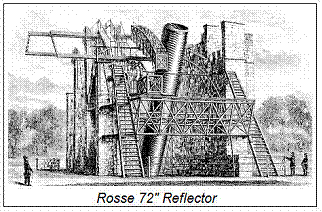Early History of the Telescope
Jack Kramer
Part II: Enter the Reflector Mirror-based optical systems soon followed refractors on the astronomical scene. The Newtonian telescope is named after Sir Isaac Newton because that is his design. But he was not the inventor of the reflecting telescope. Niccolò Zucchi is credited with constructing the first reflecting telescope in 1616, but it proved impractical because the observer's head had to block incoming light in order to view the image. It was the Scottish mathematician James Gregory who invented the first useful reflecting telescope. His design, published in a book called Optica Promota in 1663, used a parabolic primary mirror and concave ellipsoidal secondary that redirected the light back through a hole in the primary. Though telescopes of Gregorian design eventually were produced, James Gregory himself never actually made one.
 In 1668 Isaac Newton achieved the notoriety of building the first useful reflecting telescope. He did it entirely on his own, even making some of the tools used. With an aperture of 1-inch and a tube length of 6-inches, it magnified 30 times. Newton later built an improved reflector with an aperture of nearly 2-inches. In 1672 he made the 6-inch telescope that is commonly illustrated as the first Newtonian telescope.
In 1668 Isaac Newton achieved the notoriety of building the first useful reflecting telescope. He did it entirely on his own, even making some of the tools used. With an aperture of 1-inch and a tube length of 6-inches, it magnified 30 times. Newton later built an improved reflector with an aperture of nearly 2-inches. In 1672 he made the 6-inch telescope that is commonly illustrated as the first Newtonian telescope.
 Newton's study of light convinced him that refracting telescopes of the day were flawed, since they were subject to color interference. But his spherical primary mirrors produced their own aberrations, so the Newtonian design was not embraced by the astronomical community for about another hundred years. James Gregory's concept of using a parabolic primary mirror was sound. But Newton's design provided a larger field of view and could more easily be made using the technology of the day.
Newton's study of light convinced him that refracting telescopes of the day were flawed, since they were subject to color interference. But his spherical primary mirrors produced their own aberrations, so the Newtonian design was not embraced by the astronomical community for about another hundred years. James Gregory's concept of using a parabolic primary mirror was sound. But Newton's design provided a larger field of view and could more easily be made using the technology of the day.
Various telescope makers worked on improving the reflector. It accomplished two things: the problem of chromatic aberration was eliminated and there was provided a means to dramatically increase light gathering. In 1789, William Herschel constructed a 48-inch reflector, and in 1845, the Earl of Rosse built his giant telescope with a 72-inch mirror.
 Nonetheless, telescope makers were hampered by a lack of suitable material. Speculum metal, a silvery alloy of copper and tin used as the material for mirrors wasted much of the available light - it simply wasn't reflective enough. And because they quickly tarnished, there was a great deal of maintenance involved.
Published in the November 2008 issue of the NightTimes
Nonetheless, telescope makers were hampered by a lack of suitable material. Speculum metal, a silvery alloy of copper and tin used as the material for mirrors wasted much of the available light - it simply wasn't reflective enough. And because they quickly tarnished, there was a great deal of maintenance involved.
Published in the November 2008 issue of the NightTimes





